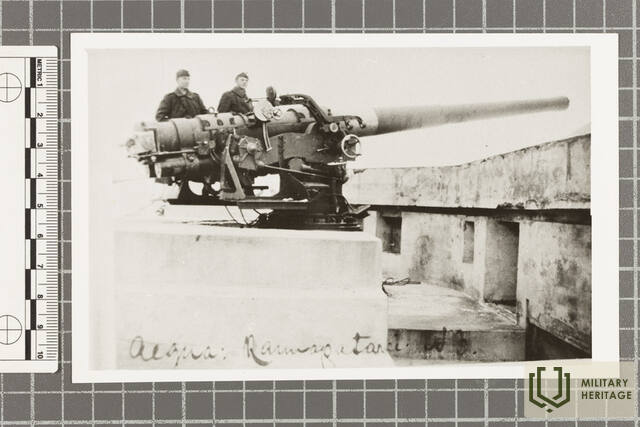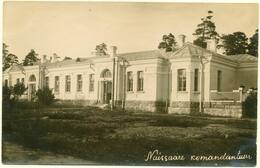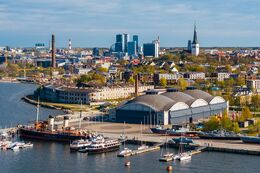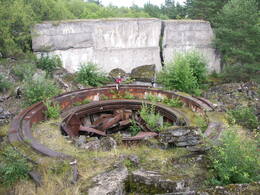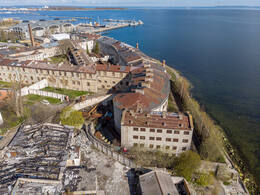Petro Didžiojo jūrų tvirtovė I WW1
Rusijos įtvirtinimų linija, nutiesta prieš Pirmąjį pasaulinį karą ir jo metu 1912–1918 m. kaip dalis Rusijos imperijos sostinės Sankt Peterburgo gynybos tiek Estijoje, tiek Suomijoje.
Kelio į Sankt Peterburgą įtvirtinimas tapo prioritetu po Rusijos pralaimėjimo Rusijos ir Japonijos kare (1904-1905). Pagrindinė linija Talinas-Naissaare-Porkkala žinoma kaip Petro Didžiojo karinė jūrų tvirtovė, kuri buvo svarbiausia ir įtvirtinta gynybos tinklo dalis.
Įtvirtinimų tinklą sudarė karinio jūrų laivyno ir oro gynybos baterijos, bunkeriai, apkasai, įtvirtinti geležinkeliai ir greitkeliai, tiltai, uostai, laivų statyklos, karinės bazės ir daugelis kitų.
Karinė jūrų tvirtovė buvo nebaigta, o 1918 m. besitraukiančios Rusijos pajėgos dalį jos susprogdino ir sunaikino. Nepaisant to, naujai suformuotai Estijos Respublikai pavyko sukurti savo pakrantės ir jūrų gynybą įtvirtinimų linijos pagrindu. Labiausiai išplėtoti statiniai Aegnos saloje.
Vėlesniuose karuose įtvirtinimai buvo naudojami retai, nes iki to laiko karyba gerokai pasikeitė. Praėjusio amžiaus šeštajame dešimtmetyje didžiosioms valstybėms atsisakius artilerijos karinio jūrų laivyno ir pakrančių gynybos praktikos, įrenginiai ir toliau buvo naudojami tik kaip sandėliai.
Šiandien beveik visi įtvirtinimai nebeeksploatuojami ir yra atviri turistams.
Susijusios vietos
Naisaro sala
Šią 19 kvadratinių kilometrų ploto salą Talino įlankoje 1912 m. įsigijo Rusijos imperatoriškasis karinis jūrų laivynas, išstumdamas vietinius gyventojus. Karinis jūrų laivynas saloje pastatė uostus, geležinkelius ir pakrantės baterijas kaip Petro Didžiojo jūrų tvirtovės dalį. Pirmojo pasaulinio karo ir Nepriklausomybės karo metu saloje taip pat buvo karo belaisvių stovykla. Naujai nepriklausoma Estijos Respublika išlaikė salą kaip sukurtos pakrantės gynybos sistemos dalį, tačiau leido vietos gyventojams į ją grįžti. Sovietų okupacijos metu salą kontroliavo kariškiai, kurie joje pastatė jūrų minų depą ir gamyklą. Naisare sovietų armijos paliktus pastatus ir įrangą vis dar galima iš dalies apžiūrėti ir šiandien. Jūrų tvirtovei suformuotas bunkerių tinklas driekiasi giliai po žeme. Kai kurie bunkeriai ir artilerijos atramos vis dar prieinami. Visą salos apžvalgą galima atlikti per dieną. Saloje anksčiau buvo tankus geležinkelių tinklas, jungiantis karinius objektus. Štai kodėl likę takai yra puikus vadovas keliaujant po salą.
Naisare yra 40 kilometrų siaurojo geležinkelio, kurio tiesimas pradėtas 1913 m., caro laikais. Geležinkelio tinklas buvo iš dalies naudojamas ir nepriklausomybės laikais, ir sovietų okupacijos metu. Šiandien atkurta 2,4 kilometro ilgio jo atkarpa. Pakrantės žmonių muziejuje salos lankytojams eksponuojamos įvairios parodos, kuriose galima išsamiau susipažinti su salos istorija. Männiku kaime, sovietmečio karių gyvenamuosiuose namuose, eksponuojama karinė paroda, kurioje pristatoma tiek ankstesnė, tiek naujausia salos karinė praeitis. Naisare švyturyje veikia paroda „Naisaras ant senų atvirukų“, kurioje vaizduojama sala jos klestėjimo laikais.
Hidroplanų uostas
Vandens lėktuvų uostas yra įsikūręs ant vandens krašto, Talino Kalamajos rajone.
Jį Pirmojo pasaulinio karo metu užsakė Rusijos imperatorius Nikolajus II kaip Petro Didžiojo jūrų tvirtovės dalį. Muziejuje, įsikūrusiame istoriniame hidroplanų angare, eksponuojama apie 200 originalių eksponatų: povandeninis laivas „Lembit“, 100 metų senumo ledlaužis „Suur Tõll“, hidroplanas „Short 184“, seniausias Estijos laivo nuolaužos, minos, patrankos ir kt. Pagrindinę parodą papildo laikinos parodos. Hidroplanų angaras yra architektūriškai unikalus: jo kupolinis stogas buvo viena pirmųjų tokio tipo plonų betoninių kevalinių konstrukcijų.
Muziejaus programos ir medžiaga individualiems apsilankymams yra smagios ir edukacinės tiek suaugusiems, tiek vaikams.
Aegnos sala
Trijų kvadratinių kilometrų ploto šioje saloje, esančioje šiaurės rytiniame Talino įlankos kampe, yra platus pakrantės gynybos baterijų tinklas ir trijų kilometrų siaurojo geležinkelio linija, nutiesta prieš Pirmąjį pasaulinį karą, tęsiant Petro Didžiojo XVIII amžiuje pradėtus įtvirtinimo darbus. Aleksandro Nevskio baterijos statyba pradėta 1915 m. 180 metrų ilgio betoninė konstrukcija abiejuose galuose buvo sujungta su barbetėmis, ant kurių buvo pastatytos po dvi 12 colių patrankas. Rytiniame gale esančios patrankos buvo aukštesnės nei vakariniame, todėl jas buvo galima šaudyti į vakarus virš kitų patrankų. 3-ioji baterija buvo pastatyta vakariniame Aegnos krante ir buvo paruošta kovai iki 1916 m. rudens. Iš pradžių buvo planuota, kad baterijoje bus šešios 130 mm patrankos, tačiau galiausiai jų buvo tik keturios.
1918 m., paskelbus Estijos nepriklausomybę, pakrantės gynybą perėmė Estijos karinis jūrų laivynas. Saloje buvo gyvenamieji namai, kareivinės, karininkų valgykla, štabo būstinė, duonos fabrikas, biblioteka, klinika, pirtis ir kt. 1927 m. saloje, Eerikneeme, buvo baigtas statyti vadovavimo centras. Tais pačiais metais buvo baigta statyti ir 10-oji baterija, aprūpinta trimis 75 mm priešlėktuvinėmis patrankomis (kurių vamzdžio ilgis – 3,75 m), galinčiomis šaudyti iki 6 km aukščio. Aegnos svarbą Estijos pakrantės gynyboje atspindi tai, kad salos klestėjimo metu pusė Karinio jūrų laivyno divizijoje tarnavusių vyrų buvo dislokuoti saloje. Esama infrastruktūra leido vietos gyventojams žiemą tvarkytis patiems, nes jūrų laivybos sutrikimai buvo dažni.
Po Antrojo pasaulinio karo Sovietų Sąjungos karinio jūrų laivyno Baltijos laivyno oro gynybos padalinys, kurį sudarė apie 100 jūrų pėstininkų, buvo dislokuotas Aegnoje iki 1957 m. Šalia Aleksandro Nevskio baterijos prožektorių bunkerio šiaurės vakarinėje salos dalyje buvo pastatyta nauja priešlėktuvinė baterija, sudaryta iš keturių betoninių pabūklų apkasų, išdėstytų 45 metrų atstumu viena nuo kitos. Buvo sumontuoti 40 mm „Bofors“ pabūklai, kuriuos anksčiau naudojo Estijos kariuomenė. Kadangi sovietmečiu Estijos pakrantė buvo draudžiama, kelionė į Aegną vėl tapo įmanoma tik septintajame dešimtmetyje. Saloje vis dar aiškiai matomi skirtingų karinių laikotarpių pėdsakai.
Patarei jūros tvirtovė
Buvusi jūrų tvirtovė, esanti Talino Kalamajos rajone.
Karo inžinierių Étienne-Louis Boullée ir Claude-Nicolas Ledoux suprojektuotas Patarei tvirtovės statybas 1829 m. pradėjo vykdyti Rusijos imperatorius Nikolajus I. Kompleksas buvo atidarytas 1840 m., tačiau tai nereiškė, kad statybos darbai buvo baigti. Tvirtovė buvo renovuota: buvo baiminamasi, kad po Krymo karo pradžios 1853 m. britai ir prancūzai puls iš Baltijos jūros. Tai iš tiesų įvyko, tačiau į didelio masto karą tai neperaugo. Iš Patarei buvo paleisti tik keli šūviai. Pradėjus naudoti sprogstamuosius sviedinius, Patarei tvirtovė 1858 m. buvo uždaryta ir vėliau naudojama kaip kareivinės. Estijos nepriklausomybės laikais Patarei buvo paverstas kalėjimu, kuris veikė iki 2002 m. Jis taip pat buvo naudojamas kaip kalėjimas vokiečių ir sovietų okupacijų metu. Šių režimų čia įvykdyti žiaurumai šią vietą pavertė liūdnai pagarsėjusia tarp gyventojų. Architektūriškai iškiliame keturių hektarų pastate dabar įrengta paroda pavadinimu „Komunizmas yra kalėjimas“, kurioje dėmesys skiriamas komunistinei ideologijai, komunistiniams nusikaltimams ir pastato istorijai. Šio nuostabaus architektūros stebuklo, apimančio keturis hektarus, renovacija prasidėjo 2020 m. Iki 2026 m. „Patarei“ taps integruotu urbanistiniu kraštovaizdžiu su komercinėmis patalpomis, gyvenamosiomis patalpomis ir laisvalaikio praleidimo galimybėmis. Rytiniame pastato sparne bus išsaugotas originalus kalėjimo interjeras ir mankštos aikštelės. Jau dabar veikia beveik 1200 kvadratinių metrų ploto paroda apie komunistinę ideologiją, žiaurumus ir pastato istoriją.




